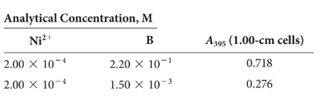
Mixing the chelating reagent B with Ni(II) forms the highly colored NiB22+, whose solutions obey Beer’s lawat 395 nm overa wide range. Provided the analytical concentration of the chelating reagent exceeds that of Ni(II) by a factor of 5 (or more), the cation exists, within the limits of observation, entirely in the form of the complex. Use the accompanying data to evaluate the formation constant Kf for the process

Trending nowThis is a popular solution!

Chapter 14 Solutions
Principles of Instrumental Analysis
- Is a quantitative separation of Zn2+ and Ag+ by electrolytic deposition feasible in principle? If so what range of cathode potential versus that saturated calomel electrode can be used? Assume that the solution is initially 0.1000M in each ion and that quantitative removal of an ion is realized when only 1 part in 1000 remains undeposited E0reduction of Zn2+ = -0.76V E0oxidation of Ag = -0.8Varrow_forwardThe following data were obtained on the initial rates of reaction of a d-metal complex in aqueous solution. For the experiments a. [Y] = 2.7 mmol/dm3, and for experiments b. [Y] = 6.1 mmol/dm3 Conc. complex/(mmol dm-3) 8.01 9.22 12.11 Exp. a. v/ (mol dm-3 s-1) 125 144 190 Exp. b. v/ (mol dm-3 s-1) 640 730 960 (a) What is the order of reaction with respect to the complex AND the reactant Y. Choose one. (b) use the data above to calculate the rate constant. k = ________ (mol/L/s, s-1, L/mol/s, or L2/mol2/s). 3 s.f. normal format.arrow_forwardThe following data were obtained on the initial rates of reaction of a d-metal complex in aqueous solution. For the experiments a. [Y] = 2.7 mmol/dm3, and for experiments b. [Y] = 6.1 mmol/dm3 Conc. complex/(mmol dm-3) 8.01 9.22 12.11 Exp. a. v/ (mol dm-3 s-1) 125 144 190 Exp. b. v/ (mol dm-3 s-1) 640 730 960 (a) What is the order of reaction with respect to the complex AND the reactant Y. (b) use the data above to calculate the rate constant. k = ________ (mol/L/s, s-1, L/mol/s, or L2/mol2/s). 3 s.f. normal format.arrow_forward
- The following data were obtained on the initial rates of reaction of a d-metal complex in aqueous solution. For the experiments a. [Y] = 2.7 mmol/dm3, and for experiments b. [Y] = 6.1 mmol/dm3 Conc. complex/(mmol dm-3) 8.01 9.22 12.11 Exp. a. v/ (mol dm-3 s-1) 125 144 190 Exp. b. v/ (mol dm-3 s-1) 640 730 960 (a) What is the order of reaction with respect to the complex AND the reactant Y. Choose one.arrow_forwardConfirm that the following CO adsorption data on activated carbon at 273 Kfollow the Langmuir or Freundlich isotherm and determine the volumecorresponding to the complete coverage of the surface.arrow_forward300 cm3 of water is added to a solution of 200cm3 of 0.5 mol dm-3 sodium chloride. What is the concentration of the new solution, showing all working?arrow_forward
- The Racah parameter B for [Co(CN)6]3−=460cm−1, and [Co(NH3)6]3+= 615cm−1. Explain the difference in nephelauxetic effect. Thank you!arrow_forwardThe formation constant for the complexation of Mg2+ by EDTA is logKflogKf = 8.79. The conditional formation constant (Kf’) at pH 8 (αY4−αY4−= 4.2 x 10-3) is: 0.037 2.6 x 106 5.14 1.5 x 1011 6.4arrow_forwardAssume that for the reaction XTP <> XDP + Pi, the Keq =272024 (dimensionless). Calculate the standard free energy change (delta Go) for the synthesis of XTP from XDP and Pi at 41.4oC in J/mol to six significant figures. Thank you for your assistancearrow_forward
- (i) You have been provided with a sample collected from a water pool beside a slag heap at the iron ore mine. 35 uL of the sample is added to 1165 uL of buffered ferrozine (excess). If the %T recorded at 562 nm in a 2 mm cuvette is found to be 25%, calculate the concentration of Fe(II) in the sample in mol L−1 and ppm. Comment on the contamination level. (ii) Comment on a possible contaminant that could interfere with the assay and suggest an approach that could be used to account for its presence.arrow_forwardGlycolic acid is used in the textile industry as a dyeing and tanning agent. Given that its acid dissociation constant (Ka) is 1.47 × 10-4 and its partition coefficient (KD) between water and benzene is 3.22, calculate the extraction efficiency of a single extraction when 50.00 mL of a 0.025 M aqueous solution of glycolic acid buffered to a pH of 3.00, is extracted once with 50.00 mL of benzene.arrow_forwardThe red color of soil is often due to the presence of iron. Metal ions are extracted from soil by stirring the soil in acid and then filtering the solution. One method for the analysis of Fe2+ is to form the highly colored Fe2+–thioglycolic acid complex. The complex absorbs strongly at 535 nm. Calibration standards of 1.00, 2.00, 3.00, 4.00, and 5.00 ppm are prepared by transferring appropriate amounts of a 10.0 ppm working solution of Fe2+ into separate 50-mL volumetric flasks, each of which contains 5 mL of thioglycolic acid, 2 mL of 20% w/v ammonium citrate, and 5 mL of 0.22 M NH3. After diluting to volume and mixing, the absorbances of the standards are measured. a)What is the effect on the reported concentration of iron in the sample if there is a trace impurity of Fe2+in the ammonium citrate?arrow_forward
 Principles of Instrumental AnalysisChemistryISBN:9781305577213Author:Douglas A. Skoog, F. James Holler, Stanley R. CrouchPublisher:Cengage Learning
Principles of Instrumental AnalysisChemistryISBN:9781305577213Author:Douglas A. Skoog, F. James Holler, Stanley R. CrouchPublisher:Cengage Learning

